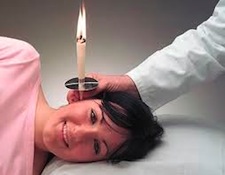It’s the time of year for saving money!

Many a long year ago, when people actually believed in Peter
Belt and his magical HiFi dealies (two examples of which were a resistor body
on a safety pin and a one centimeter purple mark to be made on ONE LP to
improve the sound of your entire record library), a couple of guys came up with
a product that they called EARWAX. Its purpose, they said was not to improve
your System, but to improve your ability to hear it in all its glory!
EARWAX was a cream priced at fifteen dollars (a LOT of money thirty
years ago) for a two-ounce bottle. What you did with it was to put some on a
fingertip and rub it into the openings to your ear canals on both sides of your
head. Thus emplaced, it was said to improve your hearing by lubricating the
“boundary layer” going into your head and make it easier for sound waves to
reach your eardrums to communicate their precious musical information.
BS? Voodoo? Solid science? Frankly, although I had my thoughts,
I had no real knowledge.
Certainly some people did hear what they claimed to be a
noticeable improvement. Others, though, did not, and like so many other things
in High End audio, it remained a subject of open warfare between those who
believed and those who did not.
There will certainly be some among those who read what I am
writing now who challenge my right to comment on this (and perhaps any other
issue of regarding HiFi tweaks): I am, after all, the former manufacturer of a
very successful line of cables – another category over which the Enlightened
and their opposite (each claiming the other to be fools or charlatans) continue
to disagree. Even so, whether you believe it or not, and whether or not any
other cable manufacturer can truthfully make any similar claim, I did approach
cable design from a purely scientific standpoint; I even made what others agree
are scientifically provable contributions to our body of provable technical
knowledge; and I do also apply scientific rigor to the evaluation of ANY
product, my own or not.
In my opinion, EARWAX was BS, intended not to improve anybody’s
listening experience, but to separate the gullible from their money.
Unfortunately, there seem to be a LOT of such products that have come to market
and some have actually enjoyed some degree of success.
I even have some idea of why that should happen: To many
people, audio, itself, is magical. They don’t understand how a squiggly groove,
a rusty piece of Mylar, or a collection of digital pits and lands can record
sound; they don’t – even though they may hold strong opinions as to which is
better – understand how vacuum tubes or solid state devices work to play it
back; they certainly don’t understand
how a single speaker goes about making the sound of many instruments or many
people singing all at the same time; and, although all claim their only desire
to be to faithfully reproduce the sound of the original “live” performance,
many have never heard live music and many more have no idea at all that, for
multi-track “lay-up” studio recordings, there may never have been any “live” performance
to reproduce.

For people like this, to whom it’s ALL magic, it’s not a big
step from the willful suspension of disbelief that allows them to accept that a
system can sound “real” to an acceptance of wire as affecting its sound. And
once they accept a concept that seemingly absurd as possible, EVERYTHING
becomes possible, and the more unlikely and the more expensive, the better. If
wires can work, then why not EARWAX? Or magic discs? Or magic bowls? Or magical
anything else at all?
Undiscriminating acceptance of both that which works and that
which has a plausible-sounding explanation but doesn’t work, is just half of
the Great Audio War. The other half is the belief of the other side that if
whatever the subject of discussion may be isn’t in the textbooks or in a
citable learned paper, it can’t possibly work, regardless of who or how many
people declare it to make a clearly audible difference.
People who believe that are just as gullible in their own way
as the others. They’re like those who denied Copernicus, Galileo and Columbus,
and, content in their orthodoxy or the power of hearsay or “common sense”, they
declare their knowledge to be complete and inviolable and roundly attack anyone
who disagrees with it.
The basic issue is one of rational analysis, and here both
sides seem to fall into the same trap: Both insist on taking a small sample to
be indicative of a much broader and often inapplicable whole. The believers insist that “Cables work, so
EARWAX must work, too” and the others, overlooking entirely the ideas of
discovery, innovation, or the combination of old information in new ways, think
that by refusing to accept the evidence of their senses they are exercising
their reason.

Neither of these positions seems reasonable to me. We DO have
intellectual and technological capital derived from centuries of science. Where
it applies, let’s accept and use it – even if it means debunking things that we
have heretofore believed and spent good money to buy: Testing and
quantification, where they can be successfully applied, can be of huge
significance in advancing our art, and to deny them is to throw away some of
our most valuable tools. Let’s also recognize, though, that testing and quantification
don’t necessarily apply in all cases. A mountain of data on any one particular
subject may not apply at all to some other.
Let’s also recognize that we don’t know everything, and that
the thing that we don’t know may be precisely the thing that makes EARWAX work
when all of our logic and all of our testing and quantification indicate that
it can’t possibly. If the reliable experience of multiple observers indicates
that something is real and works, even despite tests indicating the opposite,
let’s be smart enough to understand that we might be testing the wrong thing or
testing the right thing in the wrong way.





